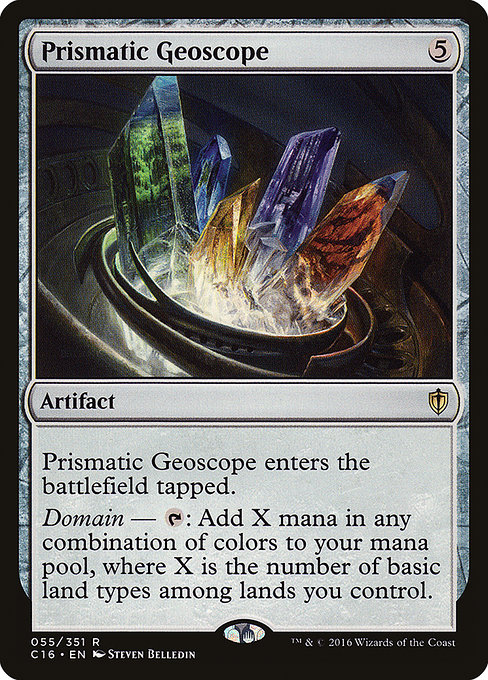
Image courtesy of Scryfall.com
Prismatic Geoscope: A Multicolor Lens on the Multiverse
If you’ve ever piloted a five-color ramp deck and wondered what a playmat-sized portal to every shade of reality would feel like, Prismatic Geoscope delivers the vibe in spades 🧙♂️. This rare artifact from Commander 2016 is less about flashy combat and more about the quiet, luminous math of mana. It enters the battlefield tapped, a small price to pay for the epic payoff: Domain — Tap: Add X mana in any combination of colors, where X is the number of basic land types among lands you control. In other words, the more colors you’ve color-typed on your land base, the more rainbow juice you can pour into your spells. Five basics? You’re producing five mana in colors you choose, potentially shaping games in dramatic, multicolored fashion 🔥💎.
Flavor, Theme, and Artwork
Steven Belledin’s artwork for this artifact radiates a spectrum of possibility, a reminder that the magic of MTG isn’t confined to a single shade. The card name itself—Geoscope—evokes a cartographer’s dream, a globe-trotting device that maps the planes of existence as if they were a gallery of doors waiting to be opened. In a Multiverse where planeswalkers chase mysteries from Dominaria to Ikoria's behemoths, this little gem acts as a fulcrum: switch on the dial of colors, and places you in contact with the very fabric of mana. It’s a perfect fit for fans who love lore that treats the five colors as distinct personalities with their own storytelling rhythms ⚔️🎨.
From a lore perspective, the Domain mechanic reads like a gateway spell for explorers who collect landscapes the way others collect gems. Every basic land type—Plains, Island, Swamp, Mountain, and Forest—becomes a stepping stone toward a bigger, brighter planewalker's turn. The artwork and the card's rhythm encourage imagineering: what stories unfold when a Red dragon-bolstered sorcerer taps into a pool that can be any color they need? What alliances form when a blue mage quietly provisions a five-color engine mid-game? The card’s flavor invites fanfiction set across the Multiverse where colors harmonize, clash, and negotiate with the kind of diplomatic flourish you only get when you can pay for it in any hue 🧙♂️🔥💎.
Gameplay and Strategy: Turning Colors into Consequences
Prismatic Geoscope is not a turn-one firecracker; it’s a slow-blooming engine that rewards thoughtful land management and color fixing. It enters tapped, so you’re already thinking a step ahead about ramp and tempo. The real magic happens when you’ve built a land base that touches all five basic land types. Then, Tap: Add X mana in any combination of colors becomes a flexible, multi-tilt projectile for high-impact plays. You can cast a late-game commander, drop a game-changing planeswalker, or slam a big five-color bomb that tilts the entire board.
In practical terms, consider a five-color or domain-focused deck that leans on land-light but mana-rich turns. You might pair Prismatic Geoscope with fetch lands, cycle lands, or other domain-enablers to maximize X in the same turn you drop your critical spells. It’s a natural home for commanders who love flexibility—cards like Child of Alara, who reward color-combinatorics, or color-agnostic finishers that want the right mana at the-right moment. And because it’s Artifact—colorless by nature—Geoscope doesn’t complicate color identity in multiplayer formats where your five colors can sing in harmony rather than collide in awkward tempo fights 🎲.
- Basic land diversity matters: The more types you control, the bigger X becomes. Aim for a balanced mix of Plains, Islands, Swamps, Mountains, and Forests to unlock the five-color potential. If you’re playing a more food-for-thought list, you can swap in duals or fetches to smooth out color access while keeping the basic land count intact.
- Ramp synergy: Don’t rely on the Geoscope alone. Pair it with rocks, signets, and efficient cantrips to accelerate into your five-color payoff, whether that’s a game-deciding commander or a mass of multicolored finishers.
- Tempo considerations: Since it enters tapped, plan your early turns around solid board presence or card advantage so your delayed mana doesn’t become a liability in the opening hours of a match.
- Commander sweet spot: In multiplayer Commander, the ability to generate any color on demand drags your group into a fascinating tug-of-war—who controls the colors matters, and Geoscope makes that control more tangible than ever.
Fanfiction Seeds: Planeswalkers Crossing Colorful Thresholds
What if a group of planeswalkers—blue scholars, red scorers, green wardens, white guardians, and black strategists—find their paths braided by a single artifact? Prismatic Geoscope becomes a plot device that forces alliances, tests loyalties, and reshapes the trajectory of a campaign. Picture an arc where a weary Teferi sketches a plan across time, a Jhoira-style inventor scrambles to stabilize the mana flow, and a Liliana-tinged schemer plots to bend the five colors to a darker purpose. The Domain ability is the connective thread: it turns color diversity into agency. Each land type you control becomes a doorway to a new planewalker's line of power, and every turn is a negotiation with the multiverse’s limits. It’s the kind of concept that invites fanfiction authors to explore how colors talk to one another when a gleaming artifact grants access to every shade the mind can imagine 🧙♂️🎨.
From a gameplay storytelling perspective, Geoscope’s presence can reflect a character’s growth—from a single-color specialist to a master of synthesis who can bend reality to their will. It’s a reminder that in MTG, the tension between color identity and colorless artifacts is not merely mechanical; it’s narrative. The five-color potential echoes the classic dream of a hero who learns to harmonize the battlefield—where every basic land type represents a different cultural or elemental faction vying for influence—and the artifact becomes the keystone of that story.